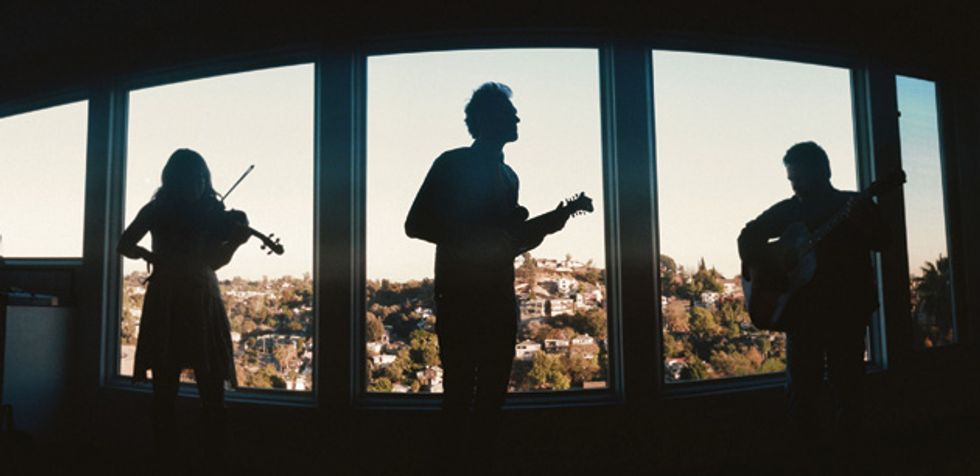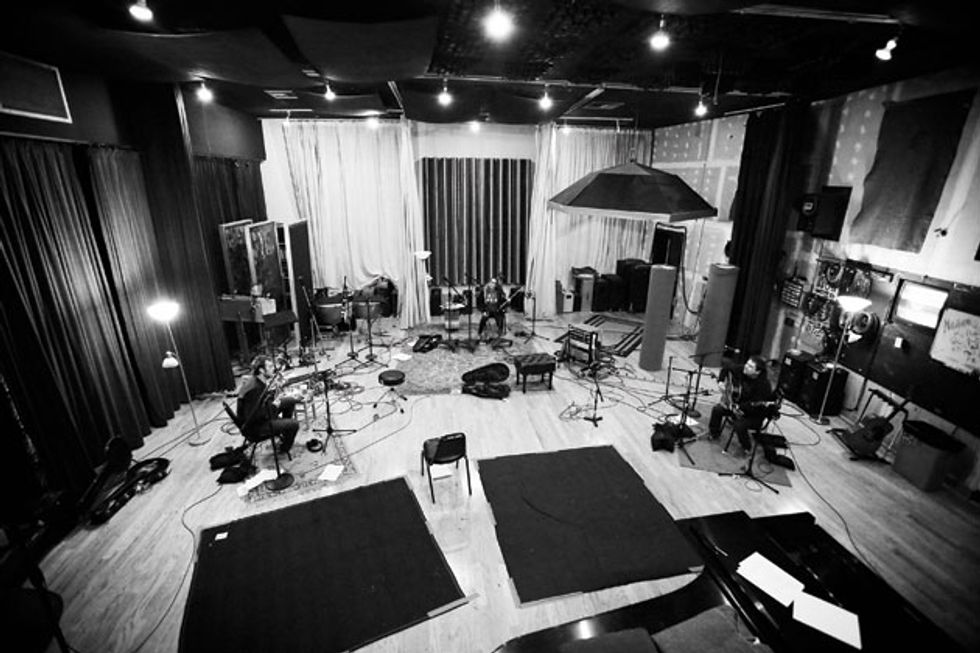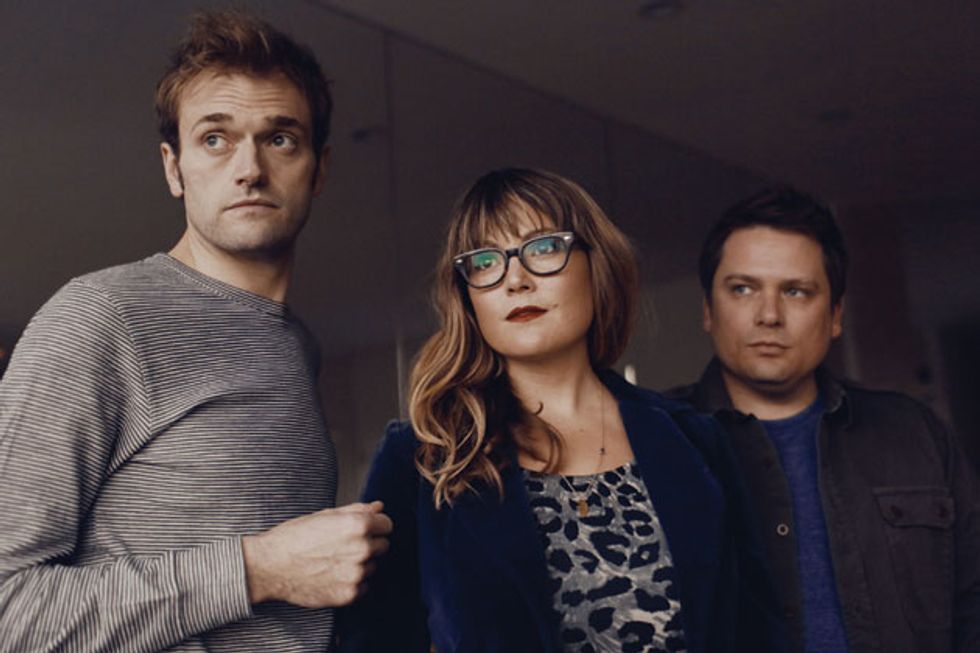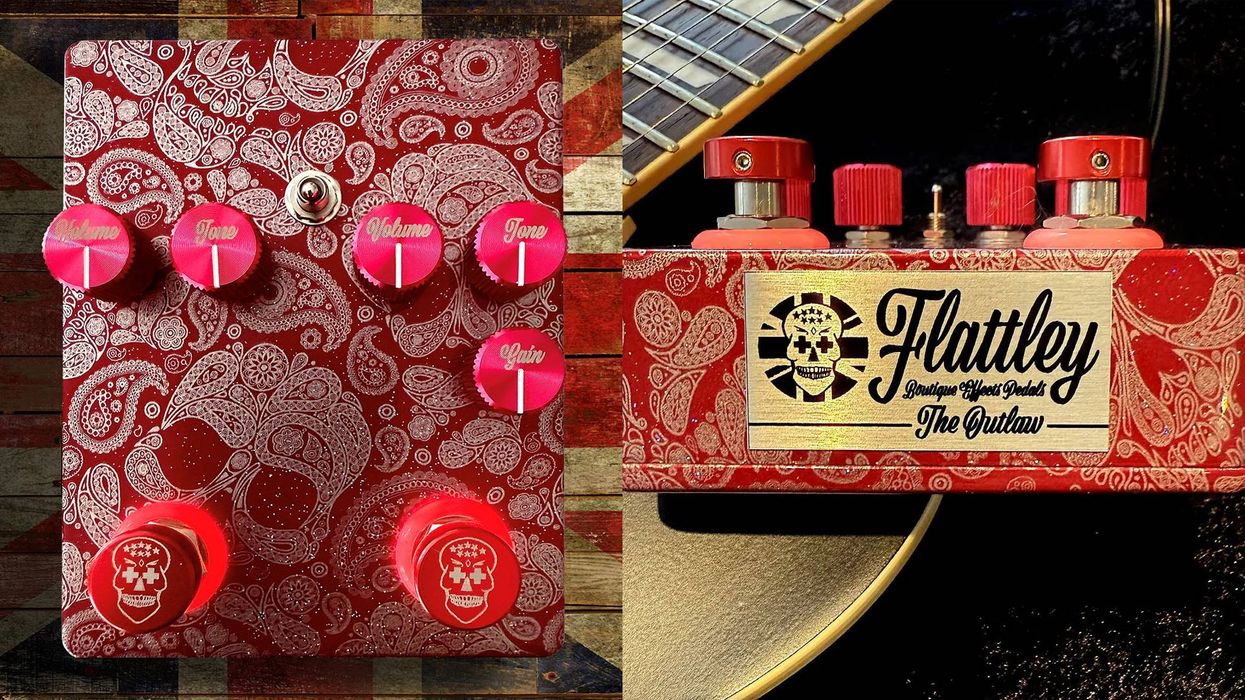Usually bands that have logged 25 years in the trenches look considerably older than Sara Watkins, Sean Watkins, and Chris Thile—the Grammy-winning members of acoustic trio Nickel Creek. At 37, Sean is the elder statesman, yet he still looks boyish for such an experienced and revered player. But that’s because he played his first professional gig—yes, with Nickel Creek—when he was 12. It was at a pizza place near his family’s home in Vista, California, and his fiddle-playing sister Sara was just 9—the same age as Thile, who was the band’s guitarist back then.
However, Thile quickly became a game-changing force on mandolin, so Watkins—who’d studied piano before switching to mandolin—switched back to guitar and the die was cast. The three child prodigies are now widely credited with helping to revitalize American bluegrass music, giving the old-time sound a jolt of youthful energy by bringing in elements of folk, jazz, classical, and indie rock. They have numerous recordings under their belt—both as a group and individually—and together they won a Grammy in the Best Contemporary Folk Album category for their 2002 release This Side, which was produced by Alison Krauss. In 2007, they decided to take time off from touring and recording together to pursue their own musical directions. Until last spring, when it occurred to them that they were coming up on Nickel Creek’s 25th anniversary.
“We’ve stayed very close since going on hiatus,” Sean explains. “We’ll always be that way because we’re family, so it was easy to talk about. I can’t remember how it started, but basically last spring we had the idea to do 25 shows to celebrate our 25th year as a band, and then to do a little EP—maybe just four or five songs. When we got together to write at Chris’ apartment in New York, right off the bat it was clear that everything was easier.
Within a week, we had good starts on about seven or eight songs. I remember at one point we looked at each other, and there was a collective, ‘Well shit, we should just make a record!’ It became clear that this was not going to be a nostalgic thing—we actually had something to say as a band.”
A Dotted Line was tracked in less than two weeks with producer Eric Valentine (Queens of the Stone Age, Slash, Taking Back Sunday), and it bristles with the natural exuberance that emerges when longtime friends and collaborators come together in a long-overdue reunion. From the driving, up-tempo “Destination,” which features wistfully lovely vocals from Sara, to Sean’s own “21st of May,” with its jaunty bluegrass visions of the coming Rapture, the album displays all the influences that Nickel Creek has absorbed over the years—introspective California folk (“Rest of My Life”), catchy acoustic pop (“You Don’t Know What’s Going On”), even electro-prog (their cover of Mother Mother’s oddball anthem “Hayloft”)—and distills them into a forward-thinking, fresh, infectious whole.
Throughout, Sean sounds thoroughly at ease in his own skin, stepping to the fore on his trusty ’54 Gibson J-45 with a confidence that has made him a musician’s musician, acclaimed among his peers as one of the most inventive guitarists in modern bluegrass. An affable guy with a laid-back sense of humor, he seems unfazed by all the attention, and much more focused on having fun.
You had a pretty small window of time to record A Dotted Line. How did you start things off with Eric Valentine?
Initially when we got together with him, we did a practice swing. We did this with [2005’s] Why Should the Fire Die? too, where we basically went in and recorded all the songs, messed around with some mics, and didn’t get too precious with it—just making demos and experimenting. We did that in two or three days, and then went our separate ways and finished up lyrics and little parts.
“Other dreadnoughts can be sparkly up top and boomy in the bass, so they seem to compete with my voice, but somehow the J-45 is a really nice companion for singing.” —Sean Watkins Photo by Brantley Gutierrez.
Eric used that time to think about what he wanted to do with each song. Then we started recording with a basic setup, and he would deviate from there, using a different mic every now and then for guitar or mandolin or fiddle. During the mixing, we definitely made comments, but he has such a great ear that, right off the bat, the sound was incredible. A lot of times, even with the best engineers, mandolin and fiddle seem to be pretty tough to get really great sounds with. A lot of people aren’t used to them, or they don’t work with them very much, and they end up sounding really tinny—fiddle, especially, is really hard. But we had amazing tones that we all loved.
You tracked all your parts with your J-45. What do you like about that guitar in particular?
I got this one about six or seven years ago. I’d been looking for a J-45 for a long time, because when we made Why Should the Fire Die? I ended up borrowing a couple of them—one from Jackson Browne, and one from Jon Brion. Eric wanted a big, dry, midrange-y sound for a few songs, especially on “Somebody More Like You,” and that guitar had it.
I picture it as like a warm, fuzzy ball of mids. Mine has great highs and lows, but the mids in it are really warm, and it’s fun to sing around. With the timbre of my voice and how I hear things, it’s clear. Other dreadnoughts can be sparkly up top and boomy in the bass, so they seem to compete with my voice, but somehow the J-45 is a really nice companion for singing. And I just like dry, woody-sounding guitars. For a long time I was playing smaller body LG and OM shapes and models, like Woody Guthrie, and I liked those because they weren’t as big on the low end and they were fun to sing with. I still enjoy playing them, but I like the fact that this is a good bluegrass guitar, as well as a fingerpicking type of guitar. I can do pretty much everything I want to do with it.
Do you remember what your first acoustic guitar was?
Around the time I was 12, I started messing with it—I think it was an older Martin D-35 that my dad had … it was a Martin dreadnought for sure. And I just started practicing. For the first few years in Nickel Creek, I played mandolin and Chris played guitar, but I remember the day when it clicked: All of a sudden I could play rhythm, and it worked. So I started learning songs on guitar, and Chris is already amazing at mandolin, so it just made sense to switch. I had a few Martins at first, and then I added a Collings D2H for a while, and a Bourgeois—I still play those frequently.
Going Barefoot
Producer Eric Valentine’s goal in the studio was to get string trio Nickel Creek to sound as powerful as the Who by spreading the players out in order to take advantage of acoustic space. Photo by Brantley Gutierrez.
Based in the gritty heart of downtown Hollywood, Eric Valentine’s Barefoot Recording studio has a history: It used to be Crystal Industries, the scene of classic sessions by Jimi Hendrix, Eric Clapton, Jackson Browne, Stevie Wonder, and many more. Valentine bought and renovated the building in 2000, mainly because he needed a large tracking room. As it turned out, this figured prominently in the making of Nickel Creek’s A Dotted Line.
“I had an interesting revelation after doing the first record [2005’s Why Should the Fire Die?] with them,” Valentine says. “I’d never done a record that was entirely comprised of those instruments, so I experimented a lot because I really just didn’t know what the hell I was doing [laughs]. I was trying to keep them physically close together in the room, and the bleed that you get when you do that becomes problematic. It causes phasing issues, and it can smear the imaging of things. It ended up working out okay, but I remember feeling like there has to be a better way to do this.
“The really simple answer was that the close mic for one instrument could become a room mic for the other instruments if it’s just simply far enough away. So I spread them out in the room more, and I feel like it worked wonderfully—the bleed of the guitar and the fiddle in the mandolin mic gives you beautiful room sound—a much better sense of the acoustic space that they’re actually playing in.”
To mic Watkins’ guitar, two vintage Schoeps M 221Bs—actually the capsules mounted in counterfeit bodies—were positioned above and below the neck. “We had one about a foot away and maybe six inches above the neck, pointing down at it, and then we had another one in the same position below, pointing up, with both somewhere around the 15th fret,” Valentine notes. “So the stereo image I can get has the strings sort of panned across, with the low strings on the left and the high strings on the right. It’s a very big sound when you need it. In the mix, Sean’s guitar is panned to one side for most of the songs, so we ended up preferring the sound of the mic that was oriented below the fretboard. I typically don’t put a microphone directly in front of the soundhole, because it’s too boomy and unmanageable.”
As it turned out, Watkins’ J-45 was naturally well balanced, so very little EQ was used, except to pull out some low midrange to make room for the acoustic bass (especially on cuts like “Destination” and the instrumental “Elephant in the Corn”). “We also used these UnderToneAudio mic preamps that we built ourselves, and we settled on a vintage Universal Audio 175B, which is an old tube compressor,” Valentine says. “Nickel Creek has these massive dynamic transitions—they’ll go from playing incredibly delicate fingerpicked parts to just slamming their instruments—so for both the guitar and the mandolin, when they slam really hard, there’s a little give in the compression and it still sounds full and musical.”
To add to the vintage analog sound, Valentine tracked the sessions through an Ampex MM1200 tape machine on the way into Pro Tools. During mixing, the band encouraged Valentine to experiment, especially on an unusual song like “Hayloft,” where the instruments needed to sound bigger. Session drummer Matt Chamberlain was enlisted to build up a groove, and then Valentine took over.
“The challenge sometimes is trying to get one acoustic guitar and one mandolin to sound like the Who,” he quips—and Valentine knows the territory, having produced albums for Queens of the Stone Age, Slash, Third Eye Blind, and many others. “You do some very intentional distortion on the acoustic instruments, with lots of compression, to make them sound really aggressive to match the intensity of the song. And I think that comes up a lot for them. A song like ‘Destination’ has these big chord hits, and you want those to sound like you’re in an arena. Those extreme dynamics were the biggest challenges in making the album.”
Photo by Brantley Gutierrez.
Did your dad have an influence on your guitar playing?
Initially it was more my teacher John Moore, who was also teaching Chris. My dad didn’t really play. He had a guitar and he knew some folk songs that he’d strum along to, but he didn’t get into bluegrass until we did—and he actually took lessons from John, too, so he could play with us. When we got to be old enough and learned some songs, he would play rhythm behind Sara and me in contests and stuff. He still plays a little bit, too.
Early on, Tony Rice was a huge influence, and within bluegrass it was Russ Barenberg, Scott Nygaard, Dave Grier, Norman Blake, and Doc Watson. I’d say probably Tony Rice, Scott Nygaard, and Russ Barenberg were my three favorites when I was young.
Sean Watkins’ Gear
Guitars1954 Gibson J-45
Strings and Picks
Elixir Nanoweb strings (.013 sets)
D’Addario EJ17 sets
Wegen TF 120 picks
BlueChip picks
How would you describe the essence of bluegrass rhythm guitar?
If you want to play bluegrass guitar, it’s definitely a specific thing. It’s a specific sound that takes a lot of the rhythmic role in the band. You’re kind of playing the kick drum and snare, with the bass notes in the strumming, so the rhythm guitar takes on a lot of responsibilities within a bluegrass band. Everybody does it a little bit different, and everybody holds the pick a little bit different, but it’s basically about keeping a really loose wrist, with your wrist pointed out so that your hand swivels, instead of just moving up and down.
It’s kind of a whip-like motion, and when I give lessons I always get people to do that first without playing. It’s like shaking your hand out like it hurts [laughs]. Once you get it, it all makes sense, so it’s always fun to show someone how to do. All of a sudden you see the light goes on, and they’re doing it, and it sounds different. It sounds like bluegrass rhythm guitar.
You mentioned the tone of the J-45, and of course the strings play into that. What’s your preferred brand—and does it matter whether they’re new or have some mileage on them?
I generally use Elixir Nanoweb .013s, but sometimes I like the regular orange pack of D’Addarios [EJ17 sets]. I don’t like strings that sound new. When I’m recording, I like to have them broken in, and when I change strings it’s just because I break one. There are exceptions, though: We were doing promos the other day and I had the same set of strings on all week, and they were nice and worn in, but I had to change them for live radio. But the Elixirs don’t tend to be as bright as other strings.
What about picks?
I really like the triangular Wegen TF 120. They never wear down and they’re not scratchy—very dependable picks. BlueChips are great, too.
You also use a capo sometimes, right?
Yeah, that’s mostly just for where I want the open notes and chord voicings to be. In “21st of May,” that’s just where the melody happens to lie, with the capo on the second fret. I wanted the third to be on top, so by playing it in the C position, the open E rings out. I definitely mess around with capo positions, especially when I’m playing with other guitar players. I like to do something opposite of what they’re doing, so if someone is playing in open G, I’ll capo on the fifth fret and play it out of the D position, and try to get some different voices that are complementary. It’s a great tool.
Do you ever use open tunings?
Sometimes I’ll use dropped-D, but I haven’t messed around with it that much. DADGAD is always fun, too. I do that on a few of the older songs with Nickel Creek.
We hear you have your own solo record coming out in June.
Yeah. It seemed like I should wait until the first wave of Nickel Creek stuff happened. I recorded it in different places—some of it on the road with Jackson Browne. He likes to take days off just to help his voice, so there was a studio in Ann Arbor, Michigan, and another one in Iowa—Cedar Rapids, I think—where we went in with Jackson, a drummer, and a bass player. I did some more of it at a beach house in San Diego that I took over for a week or so, and then some at my house here in L.A. One song I did mostly in a hotel room. I haven’t really wanted to make a solo record for a while, but I had these songs that I thought could stand on their own if I was just playing solo. So I started there, and then I added instruments and extra voices. It’s much more of an acoustic bass record, with drums on maybe less than half of it, but it’s also more acoustic guitar oriented than my records have been in the past. There are more solos, and I really took time to get the tones that I wanted.
I guess we met maybe 10 years ago. I think we were on the same bill at a place called the Lobero Theatre in Santa Barbara, and we got to know him over the next year or so. Sara and I have a residency at Largo in L.A., and I remember he came down to one of our shows and we started hanging out and playing. He’s been playing with us since then for years, and he’s taken Sara and me out on the road with him a couple of times. He’s a hero, so whenever we get to play with him, it’s just a great experience.
YouTube It
Bluegrass trio Nickel Creek—Chris Thile on mandolin, Sara Watkins on fiddle, and Sean Watkins on acoustic guitar—performs “Destination” from their new album.
























![Rig Rundown: AFI [2025]](https://www.premierguitar.com/media-library/youtube.jpg?id=62064741&width=1245&height=700&quality=70&coordinates=0%2C0%2C0%2C0)




















 Zach loves his Sovtek Mig 60 head, which he plays through a cab he built himself at a pipe-organ shop in Denver. Every glue joint is lined with thin leather for maximum air tightness, and it’s stocked with Celestion G12M Greenback speakers.
Zach loves his Sovtek Mig 60 head, which he plays through a cab he built himself at a pipe-organ shop in Denver. Every glue joint is lined with thin leather for maximum air tightness, and it’s stocked with Celestion G12M Greenback speakers.











